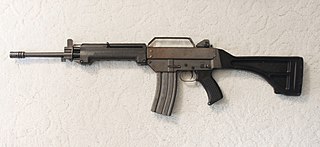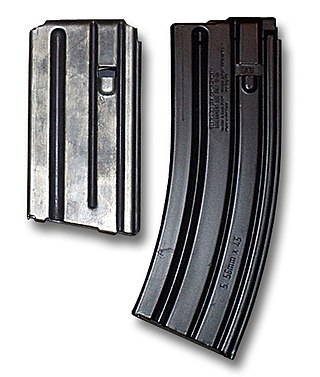
The 5.56×45mm NATO is a rimless bottlenecked centerfire intermediate cartridge family developed in the late 1970s in Belgium by FN Herstal. It consists of the SS109, L110, and SS111 cartridges. On 28 October 1980, under STANAG 4172, it was standardized as the second standard service rifle cartridge for NATO forces as well as many non-NATO countries. Though they are not identical, the 5.56×45mm NATO cartridge family was derived from and is dimensionally similar to the .223 Remington cartridge designed by Remington Arms in the early 1960s.

The Colt AR-15 is a product line of magazine-fed, gas-operated, autoloading rifle manufactured by Colt's Manufacturing Company ("Colt") in many configurations. The rifle is a derivative of its predecessor, the lightweight ArmaLite AR-15, an automatic rifle designed by Eugene Stoner and other engineers at ArmaLite in 1956.

An automatic rifle is a type of autoloading rifle that is capable of fully automatic fire. Automatic rifles are generally select-fire weapons capable of firing in semi-automatic and automatic firing modes. Automatic rifles are distinguished from semi-automatic rifles in their ability to fire more than one shot in succession once the trigger is pulled. Most automatic rifles are further subcategorized as battle rifles or assault rifles.

The .223 Remington is a rimless, bottlenecked, centerfire intermediate cartridge. It was developed in 1957 by Remington Arms and Fairchild Industries for the U.S. Continental Army Command of the United States Army as part of a project to create a small-caliber, high-velocity firearm. The .223 Remington is considered one of the most popular common-use cartridges and is used by a wide range of semi-automatic and manual-action rifles.

The ArmaLite AR-15 is a gas-operated assault rifle manufactured in the United States between 1959 and 1964. Designed by American gun manufacturer ArmaLite in 1956, it was based on its AR-10 rifle. The ArmaLite AR-15 was designed to be a lightweight rifle and to fire a new high-velocity, lightweight, small-caliber cartridge to allow infantrymen to carry more ammunition.

The ArmaLite AR-10 is a 7.62×51mm NATO battle rifle designed by Eugene Stoner in the late 1950s and manufactured by ArmaLite. When first introduced in 1956, the AR-10 used an innovative combination of a straight-line barrel/stock design with phenolic composite, a new patent-filed gas-operated bolt and carrier system and forged alloy parts resulting in a small arm significantly easier to control in automatic fire and over 1 lb (0.45 kg) lighter than other infantry rifles of the day. Over its production life, the original AR-10 was built in relatively small numbers, with fewer than 10,000 rifles assembled. However, the ArmaLite AR-10 would become the progenitor for a wide range of firearms.
The ArmaLite AR-18 is a gas-operated rifle chambered for 5.56×45mm NATO ammunition. The AR-18 was designed at ArmaLite in California by Arthur Miller, Eugene Stoner, George Sullivan, and Charles Dorchester in 1963 as an alternative to the Colt AR-15 design, a variant of which had just been selected by the U.S. military as the M16. A semi-automatic version known as the AR-180 was later produced for the civilian market. While the AR-18 was never adopted as the standard service rifle of any nation, its production license was sold to companies in Japan and the United Kingdom, and it is said to have influenced many later weapons such as the British SA80, the Singaporean SAR-80 and SR-88, the Belgian FN F2000, the Japanese Howa Type 89 and the German Heckler and Koch G36.

A battle rifle is a service rifle chambered to fire a fully powered cartridge.

The Stoner 63 is a 5.56×45mm NATO modular weapon system. Using a variety of modular components, it can be configured as an assault rifle, carbine, top-fed light machine gun, belt-fed squad automatic weapon, or as a vehicle mounted weapon. Also known as the M63, XM22, XM23, XM207 or the Mk 23 Mod 0 machine gun, it was designed by Eugene Stoner in the early 1960s. Cadillac Gage was the primary manufacturer of the Stoner 63 during its history. The Stoner 63 saw very limited combat use by US military units during the Vietnam War. A few were also sold to law enforcement agencies.
The INSAS, or Indian Small Arms System, is a family of infantry arms consisting of an assault rifle and a light machine gun (LMG). These weapons were developed in India by the Armament Research and Development Establishment and manufactured by the Ordnance Factories Board at its various factories. It was the standard infantry weapon of the Indian Armed Forces for almost three decades.

The Leader T2 MK5 Series firearms were chambered for the 5.56×45mm NATO cartridge and manufactured by Leader Dynamics of Smithfield, NSW, Australia (1978-1982/1983). The Leader was the brainchild of British weapons designer Charles St. George. It was originally a contender for a 5.56 mm Australian military service rifle to replace the then-issued Lithgow L1A1 SLR and Colt M16A1 rifles. What was unique about this endeavor was that Australia had never designed or manufactured its own commercial gas-operated semi-automatic rifle. The rifle was abandoned when the Steyr AUG was adopted for use by the Australian military.

The Heckler & Koch HK33 is a 5.56mm assault rifle developed in the 1960s by West German armament manufacturer Heckler & Koch GmbH (H&K), primarily for export.

The Heckler & KochG41 is a German 5.56×45mm NATO assault rifle introduced in 1981 and produced in limited quantities by Heckler & Koch. It was designed to replace the 7.62×51mm NATO chambered Heckler & Koch G3 and the G3 based .223 Remington/5.56×45mm and later 5.56×45mm NATO chambered Heckler & Koch HK33 service rifles providing a more modern weapon compatible with then recently introduced NATO standards. It can use both the then new STANAG 4172 compliant 5.56×45mm NATO SS109, SS110, and SS111 ammunition and older .223 Remington/5.56×45mm M193 ammunition and was the last Heckler & Koch service rifle designed around the roller-delayed blowback mechanism.

A STANAG magazine or NATO magazine is a type of detachable firearm magazine proposed by NATO in October 1980. Shortly after NATO's acceptance of the 5.56×45mm NATO rifle cartridge, Draft Standardization Agreement (STANAG) 4179 was proposed in order to allow NATO members to easily share rifle ammunition and magazines down to the individual soldier level. The U.S. M16 rifle's magazine proportions were proposed for standardization. Many NATO members, but not all, subsequently developed or purchased rifles with the ability to accept this type of magazine. However, the standard was never ratified and remains a "Draft STANAG".

The Beretta ARX160 is an Italian modular assault rifle manufactured by Beretta. Developed for the Italian Armed Forces as part of the Soldato Futuro program, the ARX160 was launched in 2008 as a commercial weapon system independent from the Soldato Futuro ensemble, complete with a companion single-shot 40×46mm NATO low-velocity grenade launcher, called the GLX160, which can be mounted underneath the rifle or used with an ad hoc stock system as a stand-alone weapon.

An assault rifle is a select fire rifle that uses an intermediate-rifle cartridge and a detachable magazine. Assault rifles were first put into mass production and accepted into widespread service during World War II. The first assault rifle to see major usage was the German StG 44, a development of the earlier Mkb 42. While immediately after World War II, NATO countries were equipped with battle rifles, the development of the M16 rifle during the Vietnam War prompted the adoption of assault rifles by the rest of NATO. By the end of the 20th century, assault rifles had become the standard weapon in most of the world's armies, replacing full-powered rifles and submachine guns in most roles. The two most successful modern assault rifles are the AK-47 and the M16 designs and their derivatives.
ArmaLite, or Armalite, is an American small arms engineering company, formed in the early 1950s in Hollywood, California. Many of its products, as conceived by chief designer Eugene Stoner, relied on unique foam-filled fiberglass butt/stock furniture and a composite barrel using a steel liner inside an aluminum sleeve, including the iconic AR-15/M16 family. While the original ArmaLite ceased doing business in the 1980s, the brand was revived in 1996, by Mark Westrom.

The CZ 805 BREN is a gas-operated modular assault rifle designed and manufactured by Česká zbrojovka Uherský Brod. The modular design enables users to change the calibre of the weapon to 5.56×45mm NATO or 7.62×39mm intermediate cartridges by quick change of barrel with gas tubes, breech block, magazine bay and magazine.
The AR-16 was an American battle rifle produced by ArmaLite.














